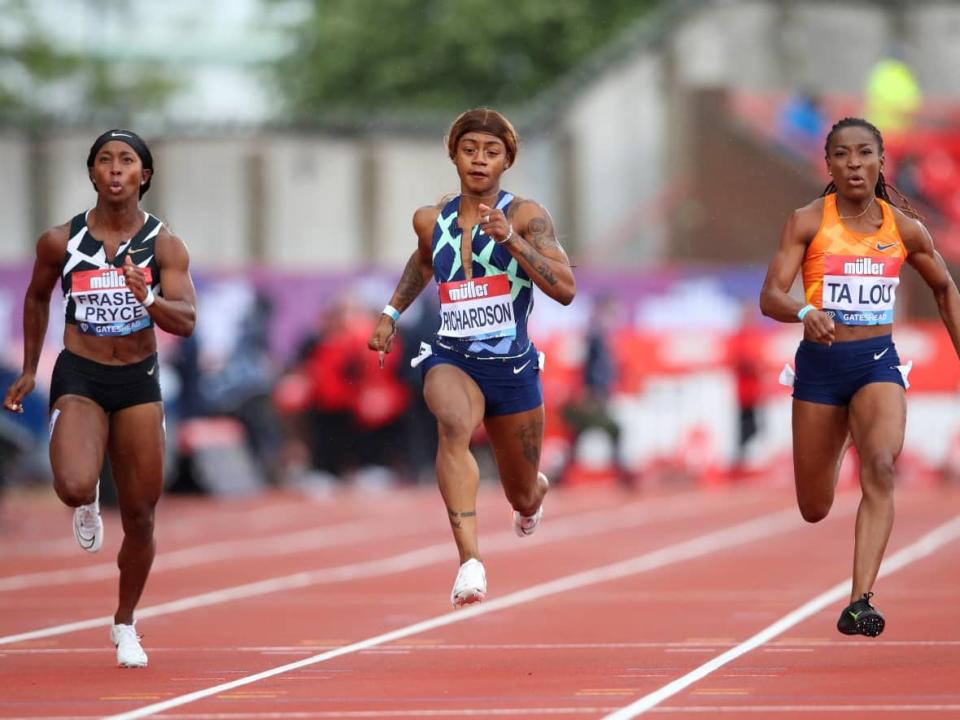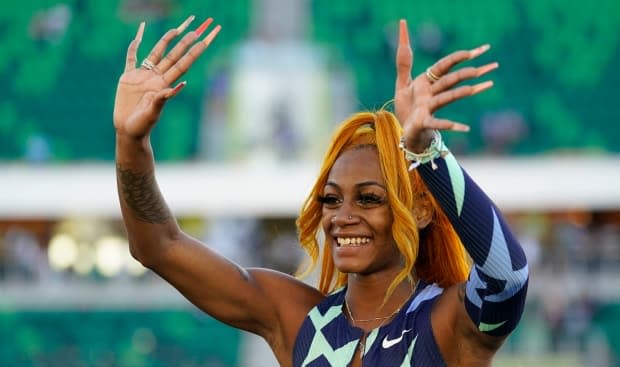Diamond League Brussels pits Sha'Carri Richardson's potential vs. Shelly-Ann Fraser-Pryce's production

This is a column by Morgan Campbell, who writes opinion for CBC Sports. For more information about CBC's Opinion section, please see the FAQ.
If you lost track of mercurial sprint star Sha'Carri Richardson after the U.S. trials in late June, well… she's back. On Tuesday she ran 11.29 seconds, on a soggy track, against a brisk headwind, to win a 100-metre race in Switzerland, and if you're eager to load the final weeks of track season with subplots, here we go:
The other seven runners greeted Richardson with some of the most reluctant congratulatory hugs ever captured on camera. Is there drama here? A hint that her fellow pro sprinters didn't welcome her return after a lengthy mid-season absence?
Maybe.
Let's see what happens in Brussels, where Richardson is scheduled to race on Friday.
Or we could view Tuesday's race as Richardson's revenge over Elaine Thompson-Herah, who beat her by a full five metres when they raced in the Prefontaine Classic last summer. With the Olympic gold medallist vanquished, Richardson can focus on Diamond League Brussels, and a showdown with world champion Shelly-Ann Fraser-Pryce. It's a sort of graduation, from a matchup with the world's third-best sprinter to a clash with the current Queenpin.
Fraser-Pryce's 10.62 second clocking in Monaco in August is the fastest on the planet this year. Add that to her gold medal in Eugene, and she's the world's fastest woman from multiple angles.
WATCH | Making a case for Shelly-Ann Fraser-Pryce as the 100-metre GOAT:
That framing fits the two-dimensional way we in the sports media view most events. We love stories about guys facing their former teams, or rematches of the previous year's title game. Revenge and rivalries reborn. For sportswriters, enough is never enough.
The truth about Friday's race is a little more ambiguous.
Fraser-Pryce pulled out of a race last Friday to tend to a minor injury. Richardson had hardly run this summer before winning that race in the rain on Tuesday. Shericka Jackson, the world silver medallist, is entered in Brussels. So are Aleia Hobbs and Marie-Josée Ta Lou, who have each run personal bests in recent weeks.
Handicapping this race is a fool's errand, and I'm not a fool.
But I'm still fascinated with the race within a race, between Richardson and Fraser-Pryce, and what their head-to-head says about the gap between potential and production. Promise and performance. Between the person making the most of her talent, and the one still trying to figure out how to tap into it.
Superficially, some similarities between Richardson and Fraser-Pryce are — to paraphrase the long-suffering crooner Richie Stephens on his classic track, "Trying to Get to You" — as obvious as the colours of their hair. Richardson first rocketed into mainstream sports fans' attention in 2021, sporting a shoulder-length, fireball-orange mane as she won U.S. Olympic trials. Since then, she has continued crafting her signature style, running in a full-body fishnet in New York, and a Flo-Jo style legging in Switzerland, sporting customized nails and eyelashes almost every time out.

And Fraser-Pryce, of course, showed off a new hair colour every day she competed at the World Championships in July, leaving the uninitiated to wonder how she could go from green-and-gold to platinum-and-fuchsia overnight.
"Important question," tweeted Peter Bromka, a writer and runner from Oregon. "How does one change their hair colors this often? I thought these colors took hours of bleaching and dying. Incredible."
Hint: they're wigs.
All those details tell us that Fraser-Pryce and Richardson both understand presentation, and their dual role as athletes and entertainers. What's the difference between running 10.7 and running 10.7 with flair? Tens of thousands of endorsement dollars, probably.
On the track, Fraser-Pryce, nicknamed the Pocket Rocket, and Richardson, who stands five-foot-one, each defy the stereotype that says diminutive sprinters start fast and fade late. They're both patient accelerators who grab control of 100-metre races after the halfway point. When they're on, they both hit their top speed at the right time, and maintain through the finish line.
With Richardson, we see flashes. At last year's Mount SAC Relays, she ran 10.74 in the semifinal and 10.77 in the final, into another stiff headwind. Those runs helped her upstage NFL star D.K. Metcalf, who lined up in the men's race, and signalled that she could still do more. A 10.7 sprinter with 10.6 ability.
But since then, we have still only seen those flashes, interspersed with detours.
The positive test for marijuana and month-long suspension that followed U.S. trials in 2021.
The lacklustre performances in the second half of last season.
A solid 10.85 second clocking in May, followed by an early exit from the U.S. trials in June, followed by another long absence, followed by last Tuesday's win. To watch Richardson is to wonder what she could achieve if she could complete a season without major interruptions, if she could use next year to build on the previous one.
Here, of course, is where the two sprinters diverge.
See the stats, count the medals
Fraser-Pryce doesn't force us to wonder.
She has run sub-11 seconds in 13 of the last 14 seasons, and medalled in every Olympics since 2008. This season, at age 35, Fraser-Pryce has recorded the top seven women's 100-metre times in the world. With Fraser-Pryce, we don't need our imaginations. We can see the stats.
And we can count the medals — 13 gold, eight silver, and a bronze in global finals.
WATCH | Fraser-Pryce runs world-leading 10.62 at Diamond League Monaco:
In short, Fraser-Pryce shows us what Richardson might achieve if she paired her stunning top-end speed with consistency, from meet to meet and season to season.
None of these details mean it's time to discuss Richardson's potential in the past tense. A generation ago, we thought of a sprinter's prime as a handful of years in the early-to-mid 20s, when they had grown into their adult strength but still had youthful reflexes, and relatively low mileage on their knees and hamstrings and Achilles tendons.
But Fraser-Pryce's career progression demonstrates that with the right combination of talent, training, maintenance and good health, a sprinter can stay near her peak for multiple Olympic cycles. For her, it has meant a gold medal and a world's best time at an age when most pro athletes are retired.
And for Richardson, it could mean a chance to settle whatever off-the-track issues have held her back and run the kinds of times she has shown us are possible. Not intermittently. Consistently, at big meets, across seasons.
Whether that will happen on Friday, against a loaded field in Brussels, won't become clear until the starter's pistol sounds. But if you're seeking subplots, Fraser-Pryce and Richardson offer them.
Jamaica versus the U.S. is an easy one, but the race also pits Richardson's still-unrealized potential against Fraser-Pryce's proven output.
It's not just age versus youth.
It's what Fraser-Pryce is against what Richardson still might become.

 Yahoo Sports
Yahoo Sports 